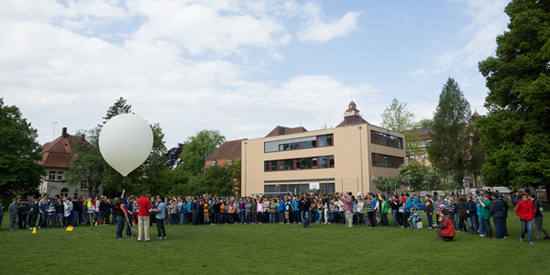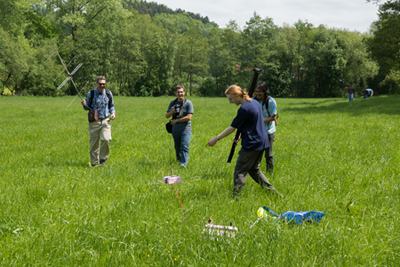Highlights
CQT tests quantum satellite components in near-space environment
Subsystems for a quantum payload built at Singapore's Centre for Quantum Technologies have flown tethered to a weather balloon to the upper reaches of Earth's atmosphere. Tests during the 18 May flight bode well for CQT plans to launch a quantum experiment on a satellite. The flight was reported on news site Space.com and in German by a television station local to the launch site.
The payload was a prototype Small Photon-Entangling Quantum System (SPEQS) from the CQT group led by Principal Investigator Alexander Ling. The group has been working to redesign and rebuild the typical sprawl of an experiment that creates pairs of 'entangled' photons in a controlled lab setting into a compact, robust package suitable for launch into space.


The weather balloon launched in Germany lofted the SPEQS prototype to an altitude of 37.5km.
Scientifically, the goal of SPEQS is to show that it is possible to create in orbit pairs of entangled photons, an experiment never done before. SPEQS will also be a testbed for technology for future quantum communication networks. Photons that share the quantum property of entanglement are intimately connected in a way that can be used for quantum cryptography, namely to secure communication channels. If entangled photons could be distributed from satellites, it would potentially extend the range of these communication channels.
Flying the SPEQS subsystems on the weather balloon is part of the team's extensive testing of its technology before launch. The balloon took the equipment close to space conditions: the maximum recorded altitude for the 18 May flight was 37.5km (for comparison, a plane on a long distance flight cruises at an altitude around 12km).

Components including a laser, crystal and single photon detectors were packed into a small payload that was suspended from the weather balloon.
"This test has been very useful, as it has provided data under very harsh conditions that are not easy to replicate in the lab", says Alexander. Prior to this test, the SPEQS subsystems were put through their paces in vibration, thermal and vacuum tests.
The team is collaborating with the Satellite Research Centre at Singapore's Nanyang Technological University to send SPEQS into orbit on a type of small satellite known as a CubeSat. SPEQS will occupy a 3cm x 10cm x 10cm slice of the satellite. The launch slot is under negotiation and could be as early as 2013.
The package for the weather balloon flight contained the crucial components of SPEQS: a downconversion source containing a laser and crystal, which splits single photons into pairs of correlated photons; two single photon detectors; and the necessary power regulators and memory chips. The flight package was powered by 8 AA lithium batteries (under lab conditions, supplying over 6 hours of operation) and fit into a small styrofoam box (pictured left). In this test, the downconversion source was not aligned to the detectors, as the primary objective was to collect data on the electronics' performance under near-space conditions.
In total the flight lasted just over 3 hours and 25 minutes, and the package was retrieved from a field some 75km from its launch site in Germany. Despite a landing at 6 m/s, the package survived the trip into the upper atmosphere, confirmed by visual and electrical tests in the lab. 12, 288 data events were successfully logged, covering all stages: ascent, rapid free-fall and descent. Sensors on the balloon indicated that the internal temperature for the instruments swung between 30 C and -5 C, while pressure changed between 950 mbar and 7 mbar. The SPEQS subsystems performed very well, adjusting both the laser power and photon detector settings according to changes in the environment. Preliminary tests in the lab showed that the alignment between the pump laser and crystals in the downconversion source were not affected despite the turbulence encountered during the free-fall stage, and the deceleration associated with landing. All subsystems are now undergoing further analysis.

The SPEQS package was recovered from a field 4 hours after launch, approximately 75km from the launch site.
"The entire team put in a huge effort to get the package designed, assembled and tested over the last three and a half months. It was also gratifying to see that SPEQS performed as expected, compensating for changes in the thermal-vacuum environment very closely," says Alexander. Implementing feedback systems to compensate for temperature swings during orbit is one of the challenges in building SPEQS. The CQT team will use the data collected to further enhance the performance of the electronics. For the balloon launch, Alexander was in Germany with CQT Research Assistant Tan Yue Chuan and collaborator Daniel Oi from the University of Strathclyde in Glasgow, who took the photos shown (see more photos here).
The CQT team thanks all those who arranged the balloon flight. Radio enthusiasts from the Susso Gymnasium in Konstanz, Germany operated the radio systems for tracking and retrieving the balloon. The amateur radio team was led by Christoph Wildfeuer, who worked with Alexander in the past at the US National Institute of Standards and Technology. Both teams are already in consultation about more ballooning opportunities in the future. Information on the flight path may be seen at http://aprs.fi, by searching for the radio call-sign: DL6MFG-11.






